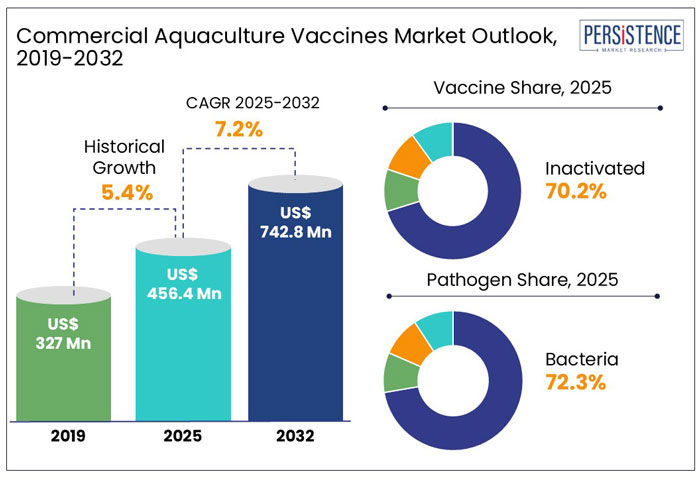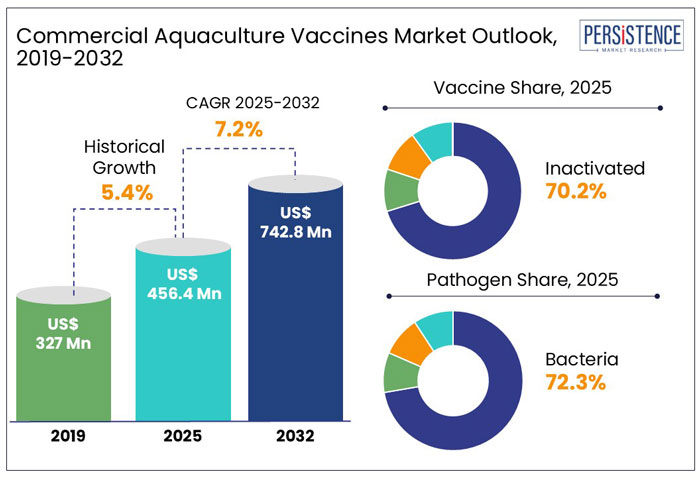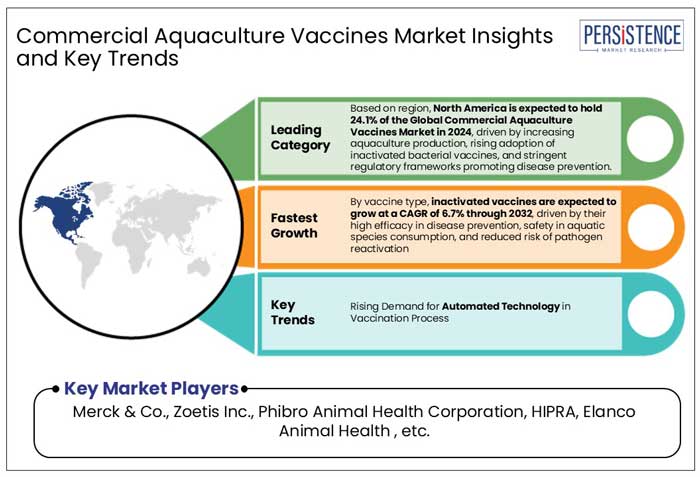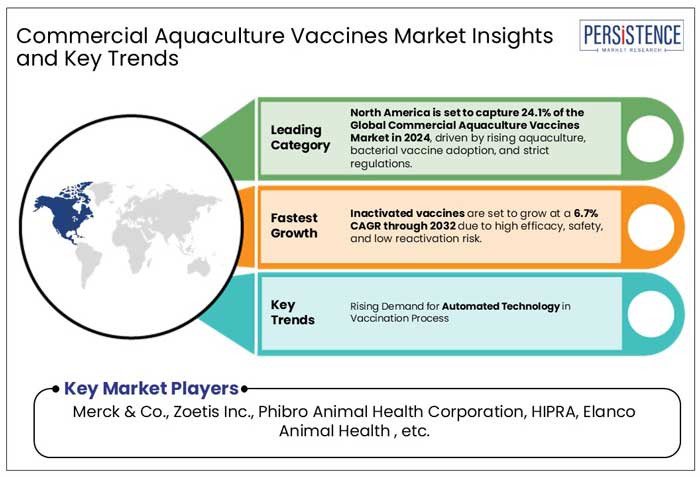ID: PMRREP32289| 366 Pages | 28 Feb 2025 | Format: PDF, Excel, PPT* | Healthcare

The global commercial aquaculture vaccines market is projected to rise from US$ 456.4 million in 2025 to US$ 742.8 million by 2032. The market is anticipated to exhibit a CAGR of 7.2% during the forecast period from 2025 to 2032.

|
Global Market Attributes |
Key Insights |
|
Commercial Aquaculture Vaccines Market Size (2025) |
US$ 456.4 Mn |
|
Market Value Forecast (2032F) |
US$ 742.8 Mn |
|
Projected Growth (CAGR 2025-2032) |
7.2% |
|
Historical Market Growth (CAGR 2019 to 2024) |
5.4% |
The global market for commercial aquaculture vaccines recorded a historic CAGR of 5.4% from 2019 to 2024.
The rising demand for aquaculture vaccinations in tropical and subtropical areas is being driven by increasing resistance to antibiotics and chemotherapeutic drugs. As a response, scientists are emphasizing the potential of third-generation DNA vaccines, which are considered safer and more stable than live, attenuated, and killed vaccines. These advancements in vaccine technology not only address drug resistance but also align with the broader need for automated vaccination technologies in aquaculture.
The manual vaccination method, while widely used, presents several challenges, including high handling stress, risk of post-vaccination infections, and local reactions—all of which increase costs, especially for small fish producers. The inefficiency of manual vaccination for small fish has further accelerated the demand for automated technologies, which aim to eliminate these limitations and improve overall vaccination efficacy.
In addition to technological advancements, the emerging trend of insurance in developed markets is playing a crucial role in aquaculture vaccination adoption. Similar to how 83% of fishermen insure their boats—an initiative supported by the Caribbean Fisheries Risk Insurance Facility (CFRIF), established by the Food and Agriculture Organization of the United Nations (FAO)—aquaculture vaccination programs are increasingly being viewed as a preventive investment. Insurance policies linked to vaccination programs can help cover the costs of potential disease outbreaks, further incentivizing their adoption.
The development of new sales channels for vaccines, medications, and veterinary healthcare services is being facilitated by third-party payers, strengthening the aquaculture industry globally. These financial mechanisms ensure greater accessibility to advanced vaccination solutions while supporting the long-term sustainability of aquaculture farming.
Ultimately, the interplay between vaccine innovation, automation, and financial support systems is driving the expansion of the commercial aquaculture vaccines market, ensuring that both large-scale and small-scale producers can benefit from these advancements.
The global market is thus likely to show high growth over the coming years at a CAGR of 7.2% and reach a global market size of US$ 742.8 Mn by 2032.
How Can Commercial Aquaculture Vaccines Market Grow?
“Increasing Aquaculture Production Fuels Vaccine Demand Growth”
The aquaculture market is rapidly expanding worldwide with large potential and an increase in fishery products. As per the FAO 2024 Statistics, aquaculture is a rapidly growing part of agriculture worldwide accounting for around 51 percent of total fish production globally.
As fish are a key source of nutrition for more than a billion people in the developing world, growing aquaculture to meet the food and nutritional needs of these consumers has become essential. However, increased production of aquaculture comes with its own challenges, including the heightened risk of diseases directly impacting fish health and production.
In order to meet this growing global demand for seafood while ensuring sustainability, there is a surge in demand for fish immunization through vaccines. This demand is expected to significantly boost the commercial aquaculture vaccines market.
Vaccination helps prevent zoonotic diseases that can spread from fish to humans or other species, protecting both farmed fish populations and public health.
This expansion will drive the need for more comprehensive disease management solutions, further propelling the commercial aquaculture vaccines market.
Can the Commercial Aquaculture Vaccines Market Growth Be Affected in Any Way?
“Regulatory Inhibitions and High Commercialization Cost”
When many animal healthcare firms promote their vaccines overseas, there are complications with respect to regulatory approval.
The regulating bodies and procedures differ from nation to nation, while many adhere to the laws of powerful nations with their own approval processes, such as the U.S. FDA. In such cases, a provider is not permitted to launch new or improved products or services before obtaining the necessary approvals.
Companies must wait for regulatory approvals before starting product distribution. Evidently, the expense of fragmented product distribution is so high that a service provider must wait years to get all necessary regulatory licenses. Such circumstances impede the market for commercial aquaculture vaccines from expanding.
The commercialization of aquaculture production is expected to incur significant vaccination costs, which are anticipated to restrain the expansion of the global market.
Current developments in vaccines and vaccinology provide worthwhile opportunities by making complex formulations that demand high manufacturing costs for the production of aquaculture vaccines.
Additionally, due to expensive vaccination processes and the availability of affordable alternatives, Asian countries primarily avoid vaccinating fish, thus restraining the growth of the overall market during the forecast period.

Why is the North America Market Booming?
“Growing innovations in Zoonotic Disease Prevention”
North America accounted for around 24.4% of the global market share in 2024. The market is booming due to rising aquaculture production, stringent regulatory frameworks, and a growing emphasis on preventative healthcare in fish farming.
Innovations such as DNA vaccines, recombinant vaccines, and oral delivery systems are improving disease resistance while minimizing environmental impact. The increasing prevalence of bacterial, viral, and parasitic infections in aquaculture has heightened the need for effective immunization strategies.
Government initiatives, including FDA approvals and funding for aquaculture health research, further propel market expansion. Additionally, consumer demand for antibiotic-free seafood is pushing fish farmers to adopt vaccination as a primary disease control strategy.
The presence of leading vaccine manufacturers and collaborations between research institutions and biotech firms are also fueling market growth. With rising seafood consumption and expanding aquaculture farms, North America remains a dominant player in this evolving market.
Will Europe Be a Lucrative Market for Commercial Aquaculture Vaccines Service Providers?
“Elimination of Administration of Antibiotics in Salmon”
Europe held the largest market share of about 39.9% in 2024 globally.
Within Europe, Norway is the biggest producer of Atlantic salmon, with production reaching 1.5 million metric Tonnes (MT) in 2022. The country has almost eliminated the use of antibiotics in salmon, one of the main meals consumed there and a significant export. As a result, an industry is thriving and the likelihood of antibiotic resistance in humans has decreased, thus driving Norway to be a lucrative country in terms of sales, within the European market, during the forecasted years.
How is East Asia Emerging as a Prominent Market for Commercial Aquaculture Vaccines Services?
“High Volumes of Fish Commercialization and Development of Novel Vaccines”
East Asia held a revenue share of around 13.9% within the global market in 2024. For sustainable fish production in East Asian countries like Japan, aquaculture is a significant business. Infectious illnesses have become an unavoidable hazard in Japan's contemporary aquaculture industry and have resulted in significant financial losses. To boost aquaculture productivity, it is imperative to find a solution to the disease problem.
Despite the fact that the nation has developed a number of efficient vaccinations against fish pathogens that have helped to prevent sickness on fish farms, infectious diseases that cannot be treated by conventional inactivated vaccines continue to be a problem. As a result, methods other than using inactivated vaccines to develop successful vaccines are needed, and this is driving East Asia to become an emerging market segment in terms of growth during the forecast period.

Which Vaccine is Driving Growth of the Global Market?
“Greater Efficacy of Inactivated Vaccines and Ease of Consumption of Aquatic Species”
The inactivated vaccines segment held around 70.2% share of the global market in 2024. Fish vaccination methods often involve inactivated pathogens, which are derived from the replication or proliferation of pathogenic microorganisms. A common approach uses formalin to neutralize harmful bacteria, ensuring they cannot cause disease while still triggering an immune response.
Inactivated vaccines contain viruses that have been rendered non-infectious through exposure to heat, chemicals, or radiation. While these viruses can no longer replicate or infect cells, they still effectively stimulate immunity in aquatic species. This approach plays a crucial role in disease prevention while ensuring that vaccinated aquatic creatures remain safe for consumption, supporting the overall health and sustainability of aquaculture.
Which Pathogen is Largely in Focus for the Manufacturing of Commercial Aquaculture Vaccines Globally?
“Rising Preference for Inactivated Bacterial Vaccines in Aquaculture to Reduce Mortality Rates”
The bacteria segment held a market share of around 72.3% in 2024. Use of bacterial fish vaccines in aquaculture is a potent technique that has been shown to offer a quick, simple, and affordable preventive treatment to fish diseases. Vaccines are known to enhance fish health, limit disease outbreaks, and give long-lasting protection against diseases while leaving no hazardous residues in the product or environment, in addition to decreasing antibiotic dependency as well as the degree of losses incurred due to illnesses.
Which Segment Holds a Greater Share in Terms of Species for Commercial Aquaculture Vaccines?
“Greater Returns on Salmon Farming”
Salmon species held a share of around 43.4% in the global market, in 2024. Large-scale commercial fish farming relies heavily on vaccination, which has contributed to the success of salmon farming. Pharmaceutical companies have conducted a great deal of research on fish vaccines, but there isn't much information available in peer-reviewed academic journals.
Additionally, salmonids dominate both the literature and the commercial focus, although accounting for a very small percentage of the world's total fish production. This fish, one of the most intensively farmed in the world, is mostly produced in Norway, Chile, the United Kingdom, and Canada.
Which Route of Administration for Commercial Aquaculture Vaccines Holds a Greater Share within the Global Market?
“Efficient Immune Response Intraperitoneally”
Intraperitoneal route of administration held a share of around 63.2% in the global market, in 2024. Since several intraperitoneally delivered fish vaccines can impart strong and long-lasting immune responses, intraperitoneal (IP) injection appears to be the most efficient immunisation approach in aquaculture. Salmonid farms have had success using commercial vaccines with IP injections of oil adjuvant.
A robust immune response at both the humoral and cellular levels is accompanied by an IP injection vaccine, which, in comparison to other vaccination methods, causes rapid changes in the peritoneal cavity's cellular composition and an increase in the quantity of macrophages, neutrophils, and other immune cells.
Which End User Offers the Commercial Aquaculture Vaccines Market a Profitable Outlook?
“Large Growth Potential for Fish Farming Companies”
Fish farming companies held a larger share of about 83.2% in the global market, in 2024. There are fish farming businesses registered on the stock exchange in Greece and Norway, and these businesses can use the stock exchange to raise equity and credit in forms of bonds.
However, fish farming is often thought to have a high-risk element and be challenging to finance. Despite this, it is considered that fish farming has a promising future and that financing will become simpler as the sector develops and matures. This segment thus holds a greater share within the global market.

Top businesses are concentrating on growing acquisitions at regional levels due to the market's consolidation. In numerous emerging regions, this trend is evident.
Players with substantial regional distribution footprint in terms of direct sales force and nearby GMP-certified production facilities supported by skilled personnel predominate in the acquisition space.
For instance:
In January 2023, Merck Animal Health opened a state-of-the-art manufacturing facility in Boxmeer, Netherlands, enhancing its veterinary vaccine production capabilities and reinforcing its global leadership in the animal health vaccine market.
By Vaccine:
By Pathogen:
By Species:
By Route of Administration:
By End User:
Region:
The global market is currently valued at around US$ 265.0 Mn in 2022.
Sales of commercial aquaculture vaccines market are set to witness a high growth at a CAGR of 7.9% and be valued at around US$ 605.5 Mn by 2033.
Demand for commercial aquaculture vaccines market increased at a 6.1% CAGR from 2015 to 2022.
Norway, U.S., Chile, Japan, and Brazil account for most demand for commercial aquaculture vaccines, currently holding around 53.5% market share.
The U.S. accounts for around 78.4% share of the North American market in 2022.
Latin America accounts for around 20.1% share of the global market in 2022.
Japan held the largest market share of about 66.5% of the East Asia market in 2022.
Germany market is set to expand at a 10.6% CAGR over the forecast period.
Brazil market is expected to grow at a 8.6% CAGR during the forecast period.
Indian market for commercial aquaculture vaccines is set to expand at a 7.0% CAGR over the forecast period.
|
Report Attributes |
Details |
|
Historical Data/Actuals |
2019 - 2024 |
|
Forecast Period |
2025 - 2032 |
|
Market Analysis Units |
Value: US$ Bn/Mn Volume: As Applicable |
|
Geographical Coverage |
|
|
Segmental Coverage |
|
|
Competitive Analysis |
|
|
Report Highlights |
|
|
Customization and Pricing |
Available upon request |
Delivery Timelines
For more information on this report and its delivery timelines please get in touch with our sales team.
About Author